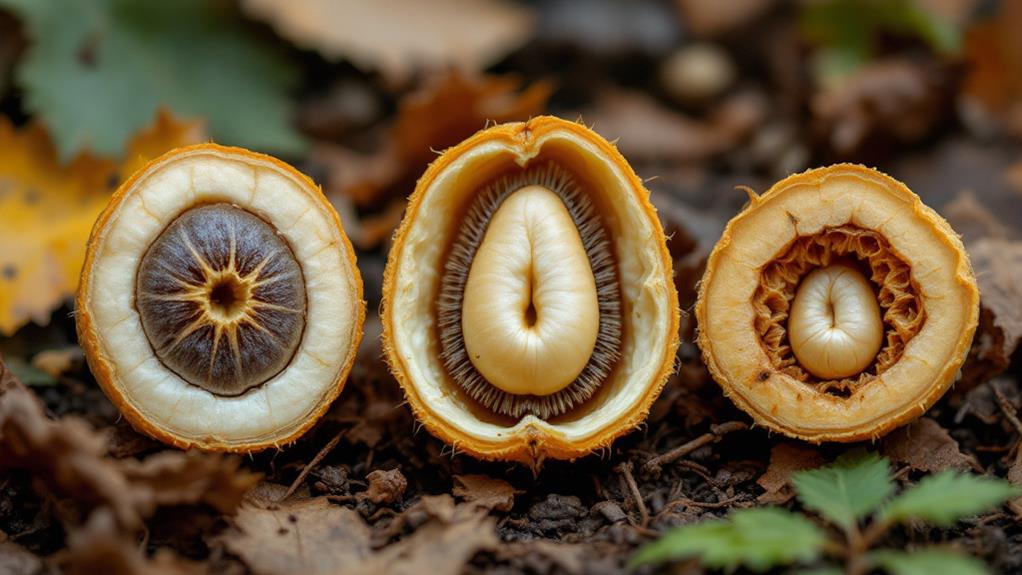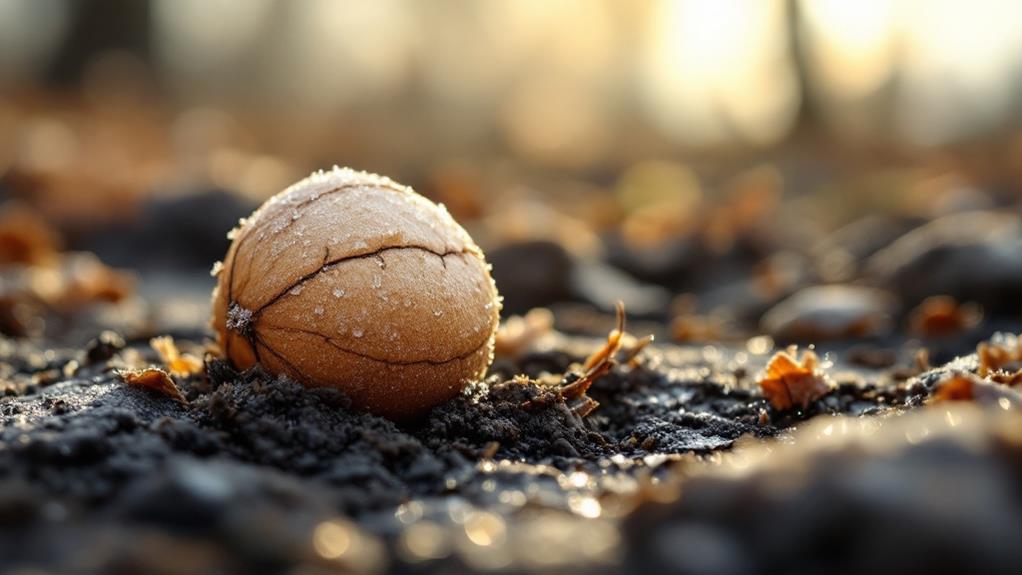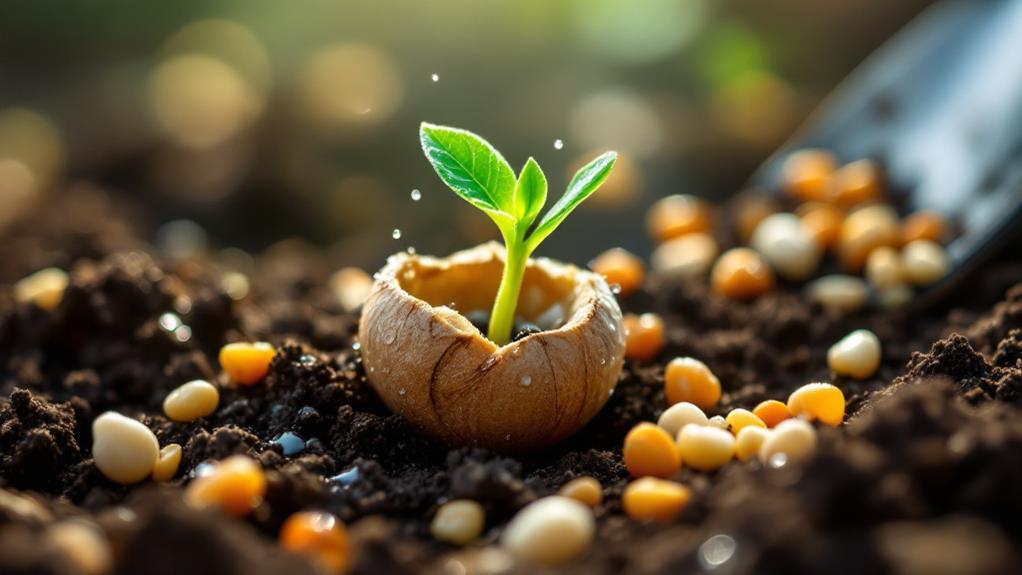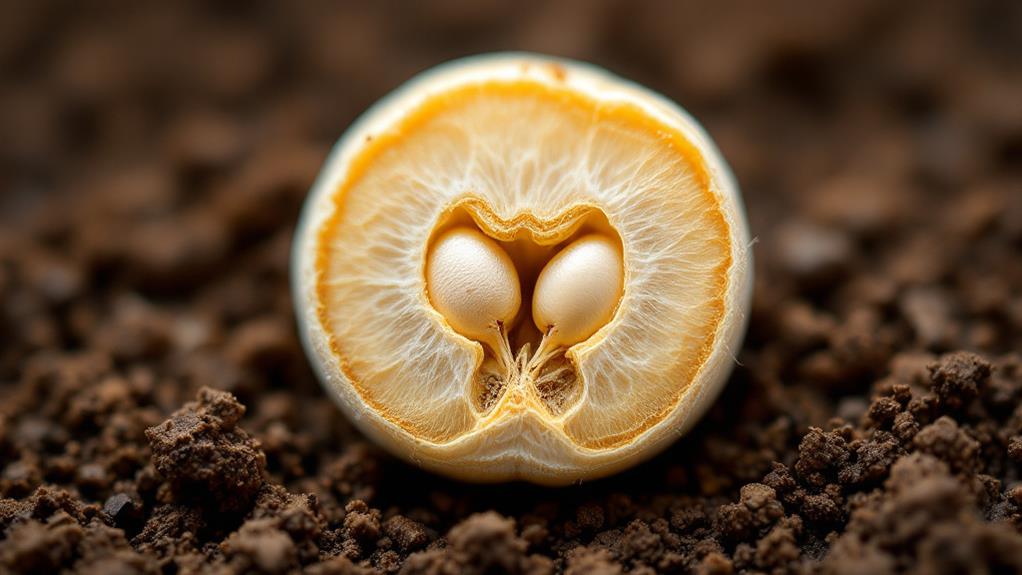Seed dormancy mechanisms are nature's way of ensuring seeds germinate under ideal conditions. You'll find various types, including physiological, morphological, and physical dormancy. Hormones like abscisic acid and gibberellins play significant roles in regulating dormancy, while environmental factors such as temperature and light exposure influence the process. Genetic control involves specific genes and epigenetic mechanisms. To break dormancy, you might need techniques like scarification or cold stratification. Understanding these mechanisms is essential for agriculture and conservation efforts. By exploring the intricate world of seed dormancy, you'll discover the secrets of plant survival and reproduction.
Types of Seed Dormancy

While many seeds are ready to germinate as soon as they're planted, others have evolved various types of dormancy to guarantee survival. You'll find that seed dormancy mechanisms are generally classified into five main categories: physiological, morphological, physical, combinational, and chemical dormancy.
Physiological dormancy is the most common type. It's caused by internal factors within the seed that prevent germination, even under favorable conditions. You'll need to expose these seeds to specific environmental cues, like cold stratification or light exposure, to break their dormancy.
Morphological dormancy occurs when a seed's embryo isn't fully developed at the time of dispersal. You'll have to wait for the embryo to grow and mature before germination can begin. This process often requires specific temperature conditions.
Physical dormancy is characterized by a hard, water-impermeable seed coat. You'll need to break or weaken this coat through scarification techniques, such as mechanical abrasion or chemical treatments, to allow water absorption and initiate germination.
Combinational dormancy involves a mixture of physiological and physical dormancy. You'll have to address both aspects to successfully germinate these seeds.
Chemical dormancy results from the presence of germination inhibitors within the seed or its surrounding fruit. You'll need to remove these inhibitors, often through leaching or prolonged exposure to moisture, before the seed can germinate.
Understanding these dormancy types is essential for successful seed propagation. You'll need to identify the specific dormancy mechanism at play and apply the appropriate treatment to overcome it, ensuring ideal germination rates for your seeds.
Hormonal Regulation of Dormancy
Plant hormones play a significant role in regulating seed dormancy and germination. You'll find that two major hormones, abscisic acid (ABA) and gibberellins (GA), are the primary players in this process. ABA promotes and maintains dormancy, while GA stimulates germination.
When a seed is dormant, ABA levels are high. This hormone inhibits water uptake, prevents embryo growth, and suppresses the production of hydrolytic enzymes necessary for endosperm breakdown. You'll notice that ABA also induces the expression of genes that produce Late Embryogenesis Abundant (LEA) proteins, which protect the seed during dormancy.
On the other hand, GA counters the effects of ABA. As dormancy breaks, GA levels increase, promoting water uptake and stimulating the production of hydrolytic enzymes. These enzymes break down stored food reserves in the endosperm, providing energy for the growing embryo. GA also encourages cell elongation in the embryonic axis, facilitating radicle emergence.
You'll find that other hormones also play supporting roles. Ethylene can promote germination by reducing ABA sensitivity and increasing GA responsiveness. Cytokinins work synergistically with GA to stimulate germination, while auxins can either promote or inhibit germination depending on the species and concentration.
Environmental factors like light, temperature, and moisture influence seed dormancy by altering hormone levels and sensitivities. For example, light exposure can trigger a decrease in ABA and an increase in GA, promoting germination in some species. Understanding these hormonal interactions is essential for developing strategies to break dormancy in agricultural and conservation practices.
Environmental Factors Affecting Dormancy

Several environmental factors play essential roles in regulating seed dormancy and germination. Temperature is one of the most critical factors you'll encounter. Many seeds require a period of cold stratification to break dormancy, mimicking winter conditions. This process, called vernalization, can trigger physiological changes that prepare the seed for germination when warmer temperatures arrive.
Light exposure is another essential factor. Some seeds are positively photoblastic, meaning they need light to germinate, while others are negatively photoblastic and require darkness. The ratio of red to far-red light can also influence dormancy, as it affects phytochrome activity within the seed.
Moisture availability markedly impacts dormancy. You'll find that some seeds have water-impermeable seed coats, preventing imbibition until the coat is physically or chemically scarified. In other cases, alternating wet and dry cycles can help break dormancy.
Soil conditions, including pH and nutrient availability, can affect dormancy. Some seeds won't germinate in soils with extreme pH levels or specific nutrient deficiencies. Additionally, the presence of certain chemicals in the soil, such as nitrates or smoke-derived compounds, can stimulate or inhibit germination.
Oxygen levels play a role too. While most seeds require oxygen for germination, some species have adapted to germinate in low-oxygen environments, such as wetland plants.
Lastly, mechanical barriers like hard seed coats may require physical weathering or abrasion to allow water uptake and gas exchange. This process often occurs naturally through freeze-thaw cycles, microbial activity, or passage through an animal's digestive tract.
Genetic Control of Dormancy
The genetic control of seed dormancy is a complex interplay of multiple genes and molecular pathways. You'll find that several key genes and hormones play vital roles in regulating dormancy. The most important hormone is abscisic acid (ABA), which promotes and maintains dormancy. Genes involved in ABA biosynthesis, such as NCED (9-cis-epoxycarotenoid dioxygenase), and ABA signaling, like ABI3 (ABA-insensitive 3), are essential for dormancy induction and maintenance.
On the other hand, gibberellins (GAs) counteract ABA's effects and promote germination. The balance between ABA and GA levels is critical in determining seed dormancy status. Genes like GA3ox (GA 3-oxidase) and GA2ox (GA 2-oxidase) regulate GA biosynthesis and catabolism, respectively.
You'll also encounter DELAY OF GERMINATION 1 (DOG1), a major quantitative trait locus controlling seed dormancy. DOG1 interacts with ABA signaling and affects the expression of genes involved in dormancy regulation. Other important genes include FUS3 (FUSCA3) and LEC1 (LEAFY COTYLEDON 1), which are involved in embryo development and dormancy establishment.
Epigenetic mechanisms, such as DNA methylation and histone modifications, also contribute to dormancy control. These modifications can affect gene expression without changing the underlying DNA sequence, allowing for flexible responses to environmental cues.
Understanding the genetic control of dormancy is essential for developing strategies to improve crop yield, seed quality, and germination timing. By manipulating these genetic pathways, you can potentially enhance seed performance and adapt crops to various environmental conditions.
Breaking Seed Dormancy

While understanding the genetic mechanisms of dormancy is significant, knowing how to break seed dormancy is equally valuable for both researchers and cultivators. You'll find several methods to overcome dormancy, each tailored to specific seed types and their natural germination triggers.
For seeds with physical dormancy, you can use scarification techniques. This involves breaking or weakening the hard seed coat. You might use mechanical methods like sandpaper or nicking with a knife, or chemical treatments such as sulfuric acid. Hot water treatments can also be effective for some species.
To break physiological dormancy, you'll often need to simulate natural conditions. Cold stratification is a common technique where you expose seeds to moist, cold conditions for a period. This mimics winter conditions and can trigger germination in many temperate species. Alternatively, some seeds respond to warm stratification.
Chemical treatments can also break dormancy. You can apply plant hormones like gibberellins, which stimulate germination. Smoke-water treatments are effective for seeds from fire-prone ecosystems, as they contain compounds that trigger germination after wildfires.
Light exposure is important for some seeds. You may need to provide specific light conditions, either constant light or alternating light and dark periods. Conversely, some seeds require complete darkness to germinate.
For complex dormancy, you might need to combine multiple techniques. It is vital to research the specific requirements of your seed species, as inappropriate treatments can damage seeds or fail to break dormancy effectively.

Erzsebet Frey (Eli Frey) is an ecologist and online entrepreneur with a Master of Science in Ecology from the University of Belgrade. Originally from Serbia, she has lived in Sri Lanka since 2017. Eli has worked internationally in countries like Oman, Brazil, Germany, and Sri Lanka. In 2018, she expanded into SEO and blogging, completing courses from UC Davis and Edinburgh. Eli has founded multiple websites focused on biology, ecology, environmental science, sustainable and simple living, and outdoor activities. She enjoys creating nature and simple living videos on YouTube and participates in speleology, diving, and hiking.

